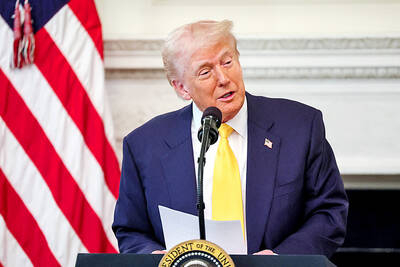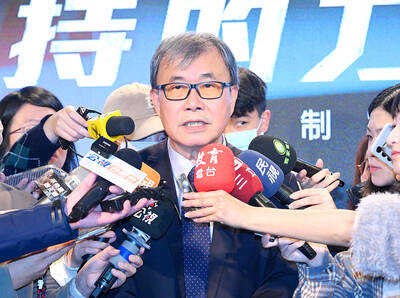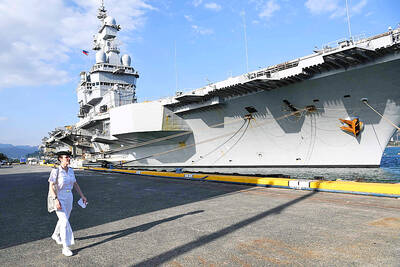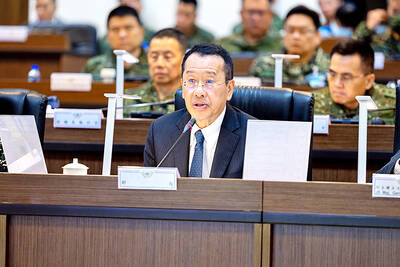Singapore’s manufacturing output fell 12.2 percent last month, more than economists expected, with the volatile pharmaceutical sector weighing heavily, official figures showed yesterday.
The data further raise the possibility that the city state, Southeast Asia’s wealthiest economy, could fall into a technical recession, economists said.
Analysts polled by Dow Jones Newswires had forecast a median 8.7 percent contraction for the month, compared with the same period a year earlier.
“It’s hard to take much solace from these numbers,” said David Cohen, director of Asian forecasting at Action Economics, a global research house.
The preliminary figures for last month followed a decline of 21.5 percent in July and a 3.0 percent gain in June, data from the Economic Development Board (EDB) showed.
The biomedical manufacturing cluster showed the biggest decline last month. It was down 33.8 percent overall, led by pharmaceutical output which dropped 35.7 percent compared with the same month last year, the EDB said. It blamed the fall on a different mix of ingredients that was produced last month.
Electronics output last month fell 7.1 percent while output in the chemicals cluster was down 6.0 percent last month, the EDB said.
Singapore’s open, trade-driven economy has been hurt by slowing global demand, and DBS Group Research said the latest output data “should provide a clue as to whether Singapore will enter into a technical recession.”
A technical recession is defined as two consecutive quarters of quarter-on-quarter contractions in the GDP.
Singapore’s growth in GDP, measured on a year-on-year basis, slowed to an annual rate of 2.1 percent in the second quarter, official data showed.
On an annualized, quarter-on-quarter basis, the economy contracted 6.0 percent in the second quarter, the data showed.
Cohen said the latest manufacturing data could translate into a third-quarter contraction as well, “which would be a technical recession.”
He said it remains to be seen what further damage could be done from this month’s turmoil on Wall Street, which included the bankruptcy of US investment bank Lehman Brothers, the merger of Merrill Lynch with Bank of America, and a US government bailout of insurance giant American International Group.
“It looks like it is finally catching up with us,” Cohen said.
US investment bank Morgan Stanley said that manufacturing accounts for about 26 percent of Singapore’s economy, adding that the latest data suggest a third-quarter recession “could be in the offing.”

STILL COMMITTED: The US opposes any forced change to the ‘status quo’ in the Strait, but also does not seek conflict, US Secretary of State Marco Rubio said US President Donald Trump’s administration released US$5.3 billion in previously frozen foreign aid, including US$870 million in security exemptions for programs in Taiwan, a list of exemptions reviewed by Reuters showed. Trump ordered a 90-day pause on foreign aid shortly after taking office on Jan. 20, halting funding for everything from programs that fight starvation and deadly diseases to providing shelters for millions of displaced people across the globe. US Secretary of State Marco Rubio, who has said that all foreign assistance must align with Trump’s “America First” priorities, issued waivers late last month on military aid to Israel and Egypt, the

‘UNITED FRONT’ FRONTS: Barring contact with Huaqiao and Jinan universities is needed to stop China targeting Taiwanese students, the education minister said Taiwan has blacklisted two Chinese universities from conducting academic exchange programs in the nation after reports that the institutes are arms of Beijing’s United Front Work Department, Minister of Education Cheng Ying-yao (鄭英耀) said in an exclusive interview with the Chinese-language Liberty Times (the Taipei Times’ sister paper) published yesterday. China’s Huaqiao University in Xiamen and Quanzhou, as well as Jinan University in Guangzhou, which have 600 and 1,500 Taiwanese on their rolls respectively, are under direct control of the Chinese government’s political warfare branch, Cheng said, citing reports by national security officials. A comprehensive ban on Taiwanese institutions collaborating or

France’s nuclear-powered aircraft carrier and accompanying warships were in the Philippines yesterday after holding combat drills with Philippine forces in the disputed South China Sea in a show of firepower that would likely antagonize China. The Charles de Gaulle on Friday docked at Subic Bay, a former US naval base northwest of Manila, for a break after more than two months of deployment in the Indo-Pacific region. The French carrier engaged with security allies for contingency readiness and to promote regional security, including with Philippine forces, navy ships and fighter jets. They held anti-submarine warfare drills and aerial combat training on Friday in

COMBAT READINESS: The military is reviewing weaponry, personnel resources, and mobilization and recovery forces to adjust defense strategies, the defense minister said The military has released a photograph of Minister of National Defense Wellington Koo (顧立雄) appearing to sit beside a US general during the annual Han Kuang military exercises on Friday last week in a historic first. In the photo, Koo, who was presiding over the drills with high-level officers, appears to be sitting next to US Marine Corps Major General Jay Bargeron, the director of strategic planning and policy of the US Indo-Pacific Command, although only Bargeron’s name tag is visible in the seat as “J5 Maj General.” It is the first time the military has released a photo of an active